The previous night had been cold, yet the day was clear and warming to around 20 degrees C.
At Mount Gambier we stopped to shop for many things: at the post office we picked up a tape from Howard which had been forwarded from Inverloch; obtained prices for the Ferry crossing to Kangaroo Island ($580 return – PHEW!!! Sorry KI, no visit from us this trip); visited the Royal Australian Automobile Association for maps of South Australia; visited National Parks and Wildlife who provided limited information on bush camping; shopped; washed and investigated electric brakes (at around $600 that wasn’t going to happen!).
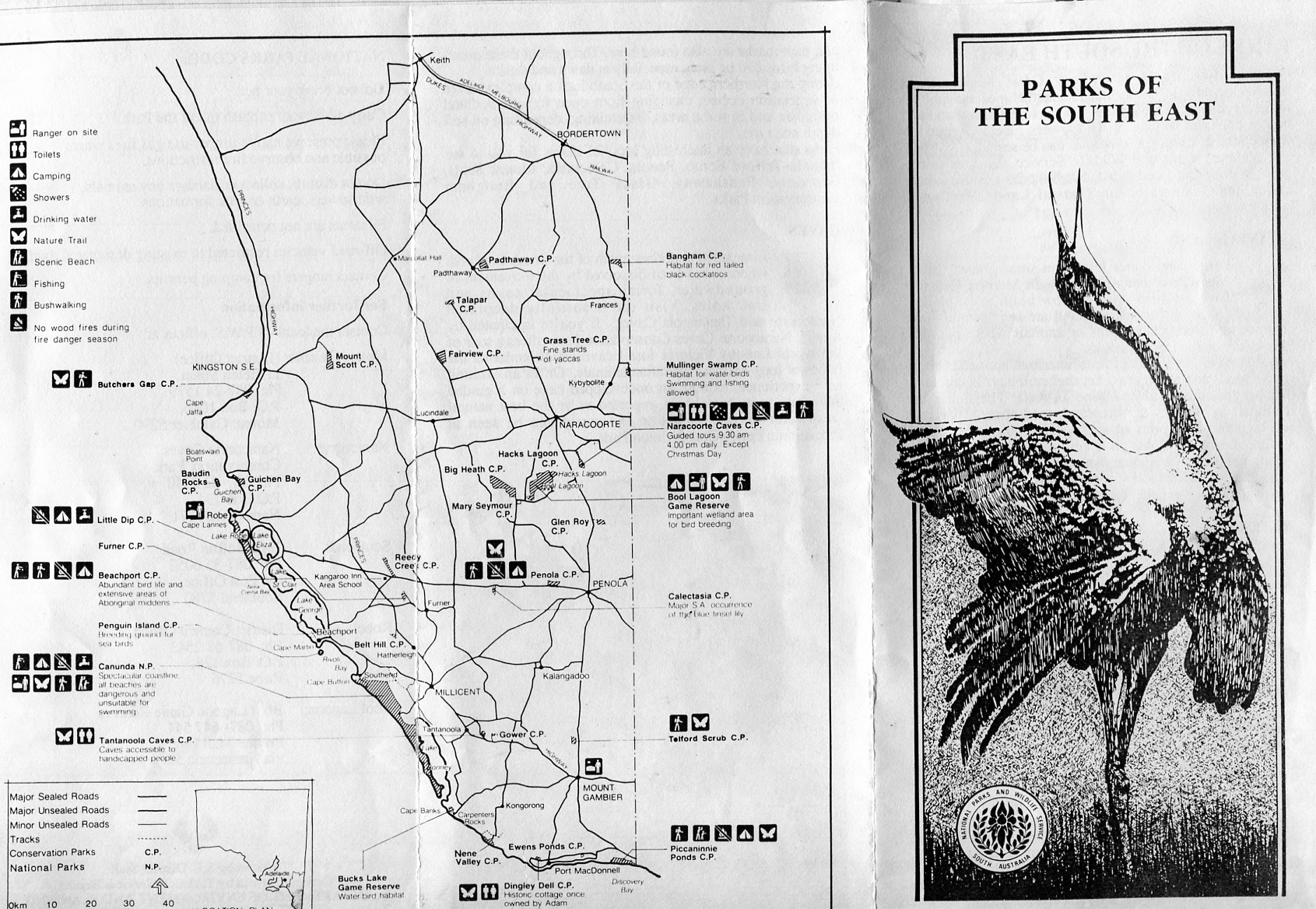
After a quick circuit of the Blue Lake, a beautiful crater lake which truly is blue, we turned out of town along Hwy 1 towards Millicent. This part of the journey was through apparently endless pine plantations, the source of Mount Gambier’s lifeblood. At Millicent we filled both the car and the caravan with petrol and water respectively.
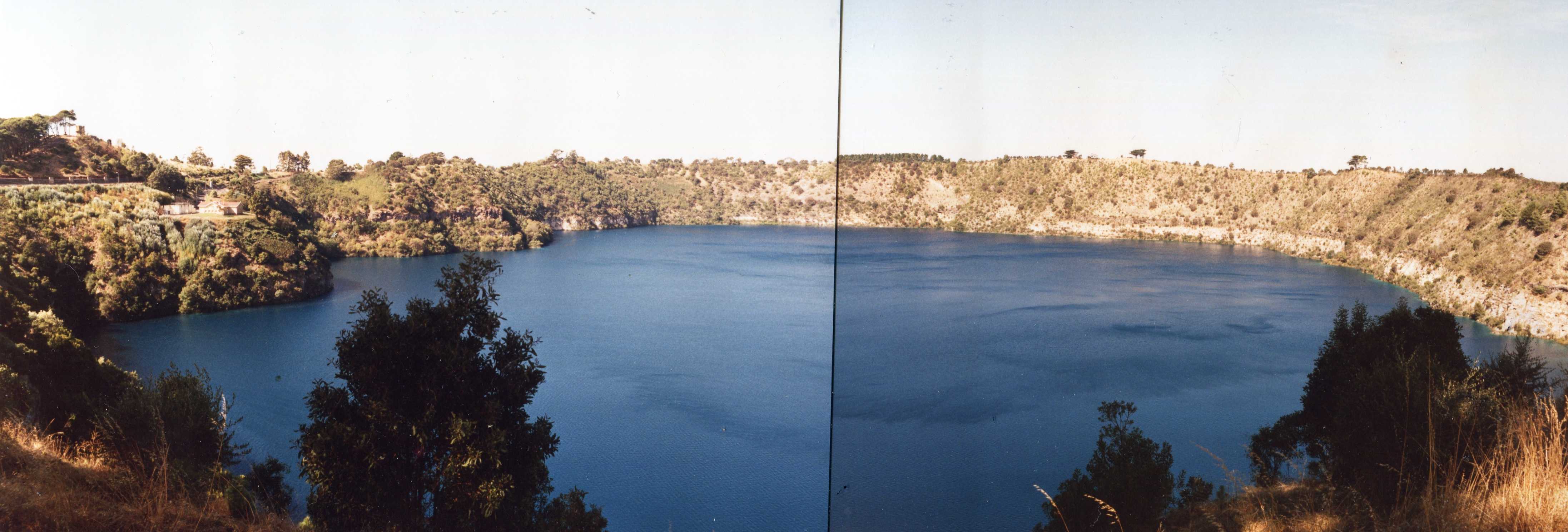
Mt Gambier's very blue crater lake
We turned off Hwy 1 for the Little Dip Conservation Park where we hoped to do some bush camping. The sites were very rough, sandy and generally unpleasant, so we opted for the expensive comfort of the Sea Vic caravan park at Robe.
The countryside between Millicent and Robe was flat, tea tree scrub, or poor grazing land built on an old sand dune system. The pastures were brown and there was little feed, yet the grazing cattle looked healthy enough.
Wednesday 14th March 1990
Lachlan went to school today at the Robe Public School. The buildings are visible through pine trees, 50 metres away from where we are camped. He went with Shane and was in the same class, prep, as his blond, long-haired earring wearing friend. From all reports and from what we could see by spying on him during lunch, he had a good time, getting on well with all those around him.
The rest of us stayed at home, read, and played mothers and fathers. Anja spent an inordinately long time sitting watching Lachlan while he was at school, frequently complaining that she should be able to go to school too.
During the cool and overcast morning I took the Anja and Rohan for a drive. Stopping off at the Post Office to check for mail, I met Pam (Post Office employee, Dick's wife and fellow Princess Margaret Rose Cave camper) who generously invited us to dinner tomorrow evening.
Robe itself is a small tourist town centred around its harbour. Geologically it sits atop strange limestone formations which show considerable internal structures including cross bedding and apparent unconformities.
When Lachlan returned from school, he and I went fishing from the old jetty, using white bait for bait, in the blue but milky waters. The only thing we caught were numerous sea lice which devoured our bait almost as fast as small fish would. The lice worked in groups, beginning on the soft parts of our bait, such as eyes, mouth and flesh exposed by the hook, before moving on to the more protected areas under scales. Another couple, who were also fishing on the wharf, were having a similar lack of success using pippies as their bait.
Earlier in the day I had witnessed the arrival of “touring rigs”. They were identical Toyota turbo diesel Land Cruisers towing huge, bogey wheeled caravans. Each was spotless and the land cruisers had aluminium boats on the roof as well as almost every conceivable accessory. Bizarre! (2020 note: no doubt grey nomads – a label that had yet to be coined in 1990)
Thursday 15th March 1990
Lachlan went to school again, this time riding his bike with Shane, who rode his also. Shane’s bike was new to him and the previous day Lachlan had found that it was too big for him to ride. Shane made it to the narrow, fenced, path behind the school and then, after falling off, found he couldn't get back on. When they arrived at school, we watched them take ages to lock up their bikes making them late for school.
The rest of the family did little during the remaining school hours. Carly was home and she, Anja and Rohan played together. After lunch I took Rohan and we walked to the PO checking out the small library on the way home.
At 4:00pm Dick arrived in his Nissan Patrol. We all piled in, drove to Pam’s father's house to pick up Dominic and Joshua and then headed for a wild ride in the Little Dip conservation park. The four wheel drive track, marked by red poles, twisted and turned through the sparsely vegetated sand dunes. Here the track was hard and smooth, there soft and rough. The further we went into the park the more difficult the track became, until finally we were stopped by a steep sand dune. Three times we tried to cross the dune and three times we were stopped only metres from the crest. Finally, after letting the tyres down to about 14 psi (38 psi is normal pressure for these tyres), Dick took the patrol over the top and we continued on our way.
The coastline was rocky and sandy, all at once, along its entire length. The big waves crashed on reefs 20 metres from shore in one place and one kilometre out in another. Yet there were sandy beaches to be found. A most unusual coastline!
At one stage we came to what appeared to be a vertical drop, at least from our point of view inside the car. Dick stopped, as he had done many times already, to check the track on foot before we proceeded. His remark “it's not too vertical”, left us little reassured and, as we went over the edge, our stomachs hit the roof of the car and everyone squealed in “big dipper” fashion.
At around 6:30 PM we headed back to Robe where Dick took us to a crayfish processing factory. We arrived to see Bruce putting big flat cardboard boxes filled with octopuses into the cool room. Earlier, as we drove over the sand dunes, Dick had explained that these cephalopods were the bane of the crayfisher’s life. Each day the fishermen could expect to get three of their 60 pots with octopus inside. The octopus killed the crayfish and, when sold, fetched $2 per Kg, as opposed to $10 to $12.00 per Kg for crayfish.
The tanks in the factory were a checkerboard of fibreglass boxes, each with wire baskets full of crayfish. Dick explained that it was possible to tell whether the crayfish had been living on weed or on the coral reefs 16Km out to sea. Those coloured red had been living on weed, while the almost white individuals were the coral dwellers. Here and there spiny legs were moving slowly above the water, as the crayfish attempted to escape. The water was very cold, specially refrigerated, to stop the crayfish from turning into cannibals which happens when the water temperature rises.
We saw ferocious velvet crabs, one of which tried to nip Dick, and huge Japanese crabs living in the tanks containing shell grit and algae. These tanks are used to cleanse the water in which the crayfish live.
From here we went to Pam and Dick’s house on the hill where we were treated to a superb meal of lasagne with a crayfish entree. It was nice to sit at a proper table and eat a meal in a civilised manner for a change.
Dick and Pam's house is made from Mount Gambier limestone blocks, double thickness, which have been cement rendered. This, we were told, is an inexpensive way to build. Dick showed us the renovations completed during the last eight years: they were both extensive and well done.
After dinner we watched our 4-wheel drive trip on the TV and talked until late. Anja, Rohan and Lachlan all went to sleep on the floor.
Friday 16th March 1990
If you sleep in you get a late start to a day of travel! Before we left Pam and Dick’s the night before, I had promised to see Pam at 11:00 AM at the post office. It was nearly 11:35 AM before we made the visit.
By 12pm we were at Kingston, 45 kilometres from Robe, where we stopped in a park for lunch. Lunch this day was special. Crayfish spiders were given to us by Shane and Carly's mum. They weren't so flavourful as those we had had in Tasmania, but yummy all the same. A spider is what is left after the tail and body flesh is removed from a crayfish. Carly's mum was employed to “pick crays”. This means removing the flesh from the legs and body for processing. She had given us a large shopping bag full of spiders and there was no way we could eat it all in one sitting. Eating crayfish in this manner is a particularly time consuming exercise. We were at the park for at least an hour before hitting the road again.
Travelling NW along Highway 1 we soon started to see salt lakes beside the road. We were entering the Coorong - a long narrow area of shallow saline lakes behind sand dunes that are part of the River Murray's disgorgement into the sea.
At Tailem Bend the mighty Murray itself came into view, the lush green irrigated land on one side in stark contrast to the dry, brown lands elsewhere. Not far from Tailem Bend our next stop was Murray Bridge. Here we got money, food and drink as well as filling with fuel and visiting the national Parks and Wildlife service of South Australia. NPWS SA don't provide as good information as their counterparts in Victoria. They couldn't provide information on parks outside their region and even within their region they couldn’t tell us whether we could camp or not.
From Murray Bridge we crossed the Murray river again and travelled to Mannum, on the river’s eastern side. We crossed back again on a vehicular ferry, much to the delight of the kids. Here the river is wide and deep, supporting a houseboat building and renting industry. We had only travelled 50m from the ferry when we saw a large paddle wheeler steamer which insisted we stop and have a closer look.
From Mannum we travelled intially parallel to the Mannum/Adelaide pipeline: a 2m diameter gleaming silver affair which periodically dons tar and ducks underground so the local cocky can use his gates. Here the country became extremely dry, almost barren, sheep country from which it appeared nearly all the trees had been removed. One paddock that had been burned was desert like. We reached Eden Valley municipal campground, booked in with the caretaker and had dinner just after dark. Even though the buildings for the amenities block are from the 1930s, the showers etc within are very much 1990s.
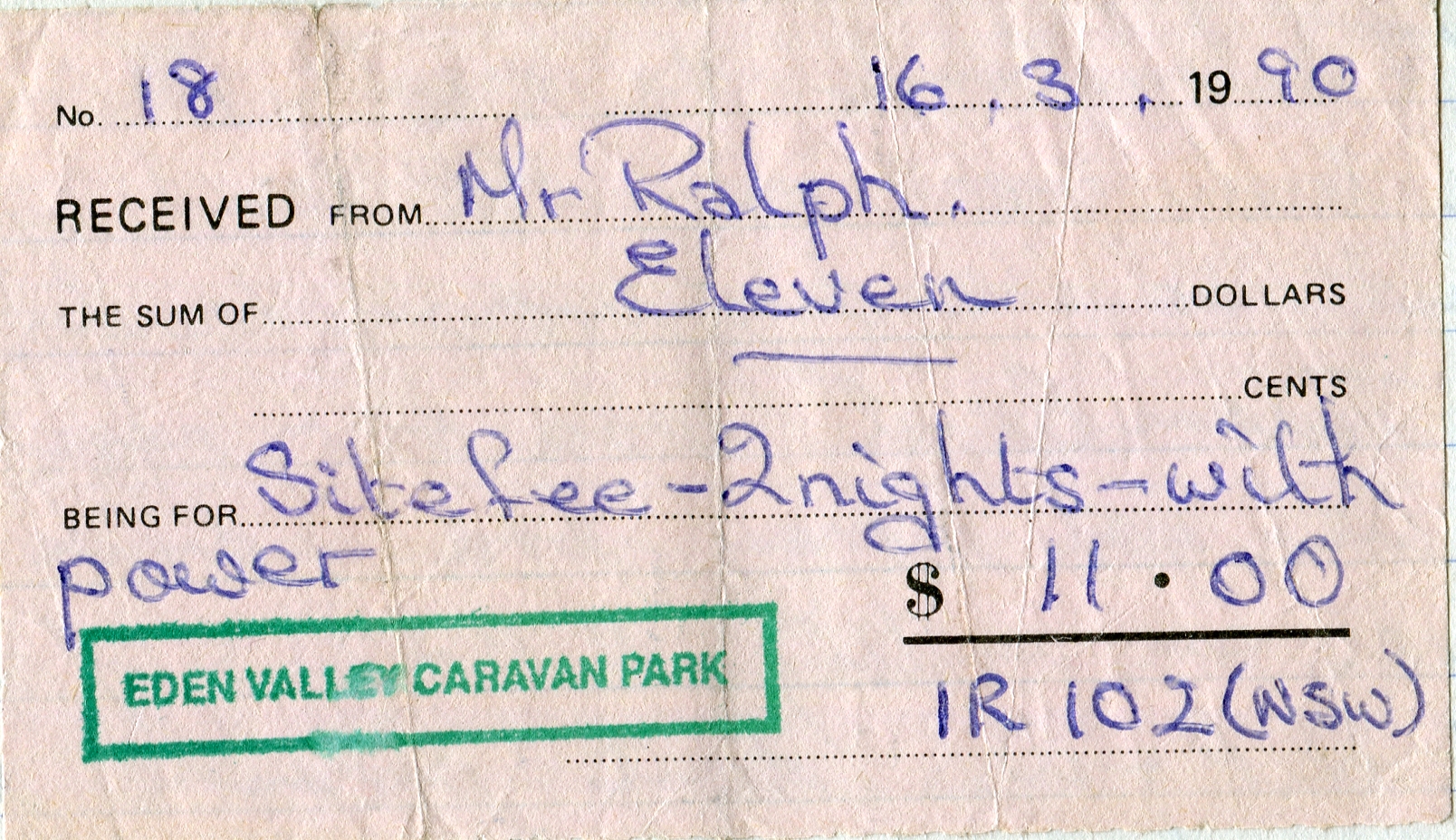
A full time resident at the camping ground, and the only other resident we have seen, Ken, lives in a caravan nestled next to the shower block. He had a bitch called Quartz who had given birth to six puppies the day we arrived.
Saturday 17th March 1990
The night had been clear and cold, but the morning promised a warm day as we ate breakfast outside.
After Jacqui hung out the washing, which had been done in a plastic box filled by the shower rose, we all went into Mount Pleasant for the annual show. We had a great day.
We gave Lachlan and Anja $5 each and of course spending this was their number one priority. Lachlan started with a $2 game of drop the ball down the clown’s mouth. Rohan followed suit; however, he by-passed the middle man by putting the $2 coin straight down the clown's mouth. The owner wasn't amused, as was clear as he dismantled his clown to retrieve Rohan's coin. Anyway, Lachlan was happy with the black plastic stick on lizard and white skeleton he had won. Anja and Rohan were happier with a ride on a simple merry-go-round.
Next came food in the form of toffee apples. As the kids ate their apples we sat and watched the merino rams being judged from the top row of a wooden grandstand. Three cute kids, eating toffee apples, made an irresistible combination for a photographer from the local newspaper. He took our names and addresses and promised to send any paper where the photographs were used. (2020 note: we never received a copy of the paper).
The rest of Lachlan’s money went on a can of Coke and a chocolate crackle on a stick with an RRP of $0.50. He got it for $0.40 my sweet talking the lady.
Lunch in the local park, then back to the show. First in the afternoon session was show jumping, followed by chickens, goats, tractors, cows etc. Wine tasting was popular, but at $7.00 for each glass, was out of our price range. We left the show after collecting 25 aluminium cans and half a dozen bottles for their refund value. Lachlan collected them and we carried them!
Sunday 18th March 1990
We all slept in, but it was still only 7:30 AM when we struggled out of bed. The only advantage I can think of when daylight saving ends!
While Jacqui did some paperwork, I took the kids and we drove in a loop through Angaston and back to Eden Valley. Everywhere the country is dry with the occasional patch of green where a farmer or wine company had planted grapes. In one paddock eucalyptus had been planted in pine-forest-like rows. Just before Angaston, racehorse studs had tubing covered wire on the fences and practise tracks.
The day was overcast with a strong cold wind from the south. Ideal weather for Ken to bring out his kites, much to the delight of the kids.
After lunch we “did” wineries and a dried fruit company. Yalumba had superb old buildings but in my humble opinion their cheapest wines at $5 per bottle lacked body and character. At the Angus Park dried fruit company, we battled to find space amongst two coachloads of visitors crowded into the small display and sales room.
Saltrams was next but again price beat us. They did have mellow port at $2.80 per litre. We decided to return tomorrow with a wine bottle.
Monday 19th March 1990
Getting an early start is fine in theory but, due to a sluggish tendency amongst the young members of the tribe, it was 10am before we left Eden Valley.
During the morning I had to repair one of the bolts which attaches the uprights to the roof, it had pulled through the three-ply and aluminium of the wall. We also filled the water tank with rainwater: a waste of time, and Eden Valley's precious tank water, as you shall see.
At Angaston we stopped off at the Angus park company and bought bananas and carob drops. About 2 kilometres down the road I pulled over opposite Saltrams and ran in clutching an empty screw top wine bottle of that had contained Best’s dry white. I was the only one in the tasting room at the time and I asked for it to be filled with mellow port at $2.80 per litre. Had I known what consternation such a request would cause I may not have bothered. “Well we normally don't sell it in quantities of less than two litres , but I'll ask” the young lady disappeared into an office and came back saying “okay but you'll have to pay $2.80 for 750ml”. I agree.
The trip North from Angaston to Clare was about 15 minutes longer than necessary due to a wrong turn at Nuriootpa. Ironic, in that the day before we had been praising ourselves as we hadn't been lost. The land on either side of the road was frequently a vineyard, either bursting with fruit, recently harvested or in the process of being harvested.
At Claire we did all the usual things including lunch, money, food and then headed North for Wilpena. As we travelled further north, the land flattened and dried, large trees disappearing except in the creek beds and the Wilpena Ranges looming large and blue on the horizon. From Orroroo we travelled along 60 to 70 kilometres of dirt road which was good enough to allow an average speed of 80 to 90 kilometres per hour. Along the way we saw a numerous crumbling homesteads and one fox. When we looked on the map we found our latitude to be roughly that of Fowlers Gap so we decided the Fox must be one of Nicky's (2020 note: Jacqui’s sister Nicky, was doing or had recently completed he PhD on fox control at Fowler’s Gap, north of Broken Hill)
At Hawker, which Jacqui notes is an electorally swinging seat, only 52 kilometres from Wilpena we stopped for fuel. After paying I notice the car was not sitting correctly and a found the valve for the air shocks had been broken by flying rocks. The garage had spares but not the piece I required. When I walked out, to add insult to injury, the rainwater we had put in the tank was steadily dripping out from the water tank. Water hose connections had been hit by rocks and were leaking. The proprietor was very helpful and directed us over the road. Here they had the part, but as a component in a much larger kit and priced prohibitively at $32
We drive to another garage where they searched in vain. Back to the second garage who agreed to separate the kid and we separated with $6. We pumped up the suspension to the highest pressure supplied by the garage: 90psi. 115psi is needed but that will have to wait for another garage.
After all this, instead of driving to Wilpena we opted to stay in Hawker, fix the tank in the morning and drive to Wilpena as a day trip.
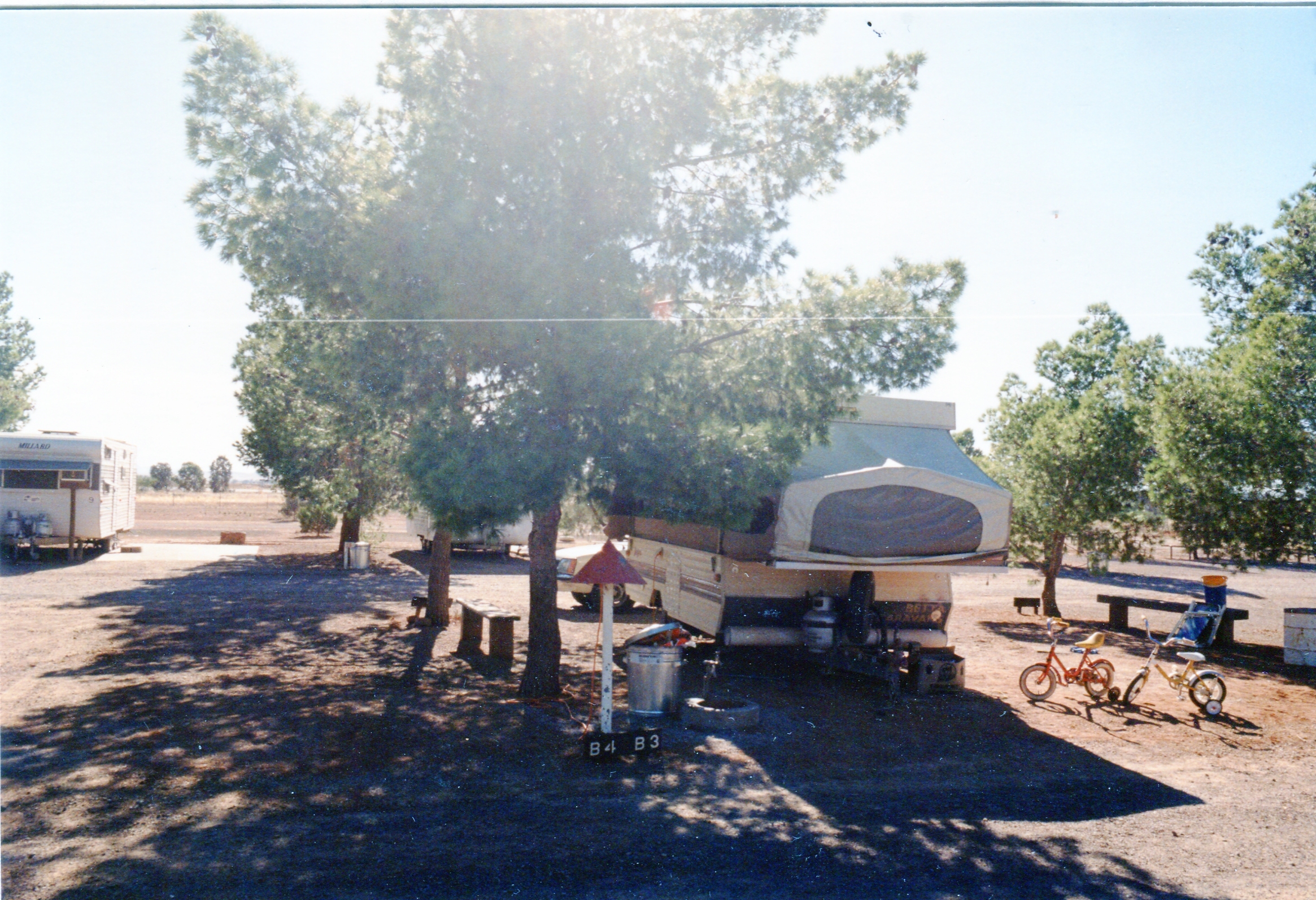
Our grass free Hawker campsite
The day’s finale was that the extension lead, used to power lights etc. outside the van, burnt out.
Tuesday 20th March 1990
After an unfamiliarly warm night, by the time we emerged for breakfast at around 7:00 AM, the sun was well and truly up and doing a good job adding to the warmth of the night.
Breakfast out of the way (my idea to buy Muesli instead of Weet Bix went down like a lead balloon amongst the kids) and Jacqui working on the washing, I took some of the kids into town to buy new connectors for the water tank. Unfortunately, they were not to be found. Instead I decided to close one end of the holes with epoxy and replace the broken connector with the good one, improved with some plumber’s tape.
The trip to Wilpena Pound was an excellent tarred road and it didn't take long to travel 54Km. As we travelled, the Flinders Ranges loomed blue against the brown grass and low scrub off to the west.
After making enquiries at the shop, we raced off after a council worker’s Falcon Ute. Jacqui, bold as brass, went up and asked for a lift into the Pound. She was successful!
So, we all piled into the ute, Anja, Rohan and Jacqui in the front with Robert, the driver, and Lachlan and I sat with the toolbox in the back. We drove slowly through the opening of the Pound, along a creek bed. In many ways it was like Halls Gap in the Grampians. Along the way we saw emus and wallabies.
At the old homestead, Robert left us, and we started to walk up the dip slope of the range which forms the enclosed pound. After only 150 metres we had a superb view of the pound and the ranges on all sides. The kids walked well with only minimal complaints.

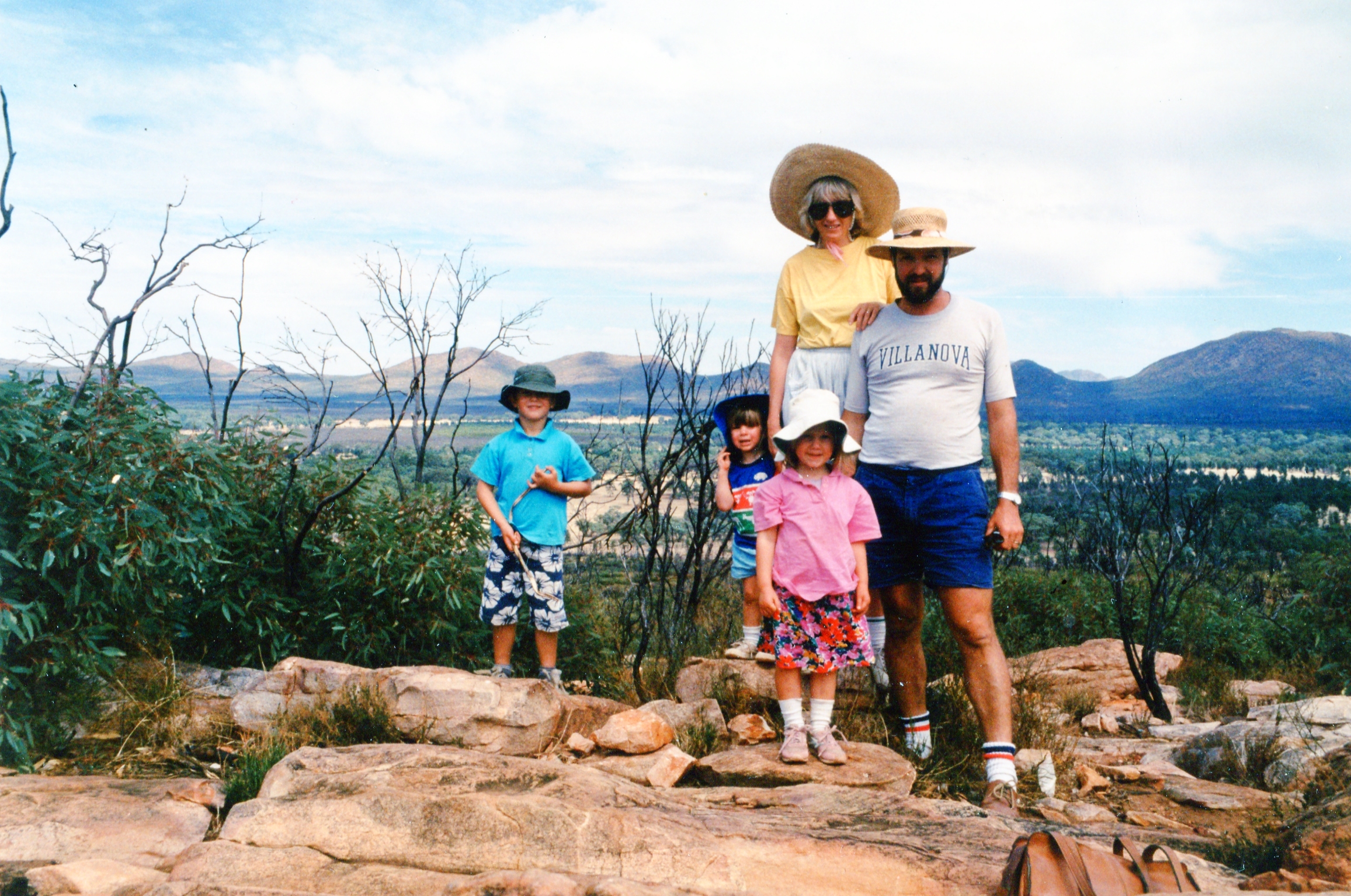
Overlooking Wilpena Pound
We missed Robert when he left, so we walked out. This took around an hour and only required minimal coaxing.
Back at the car we ate lunch and headed north to return via Brachina Gorge to Hawker. This return journey was the highlight of our day.
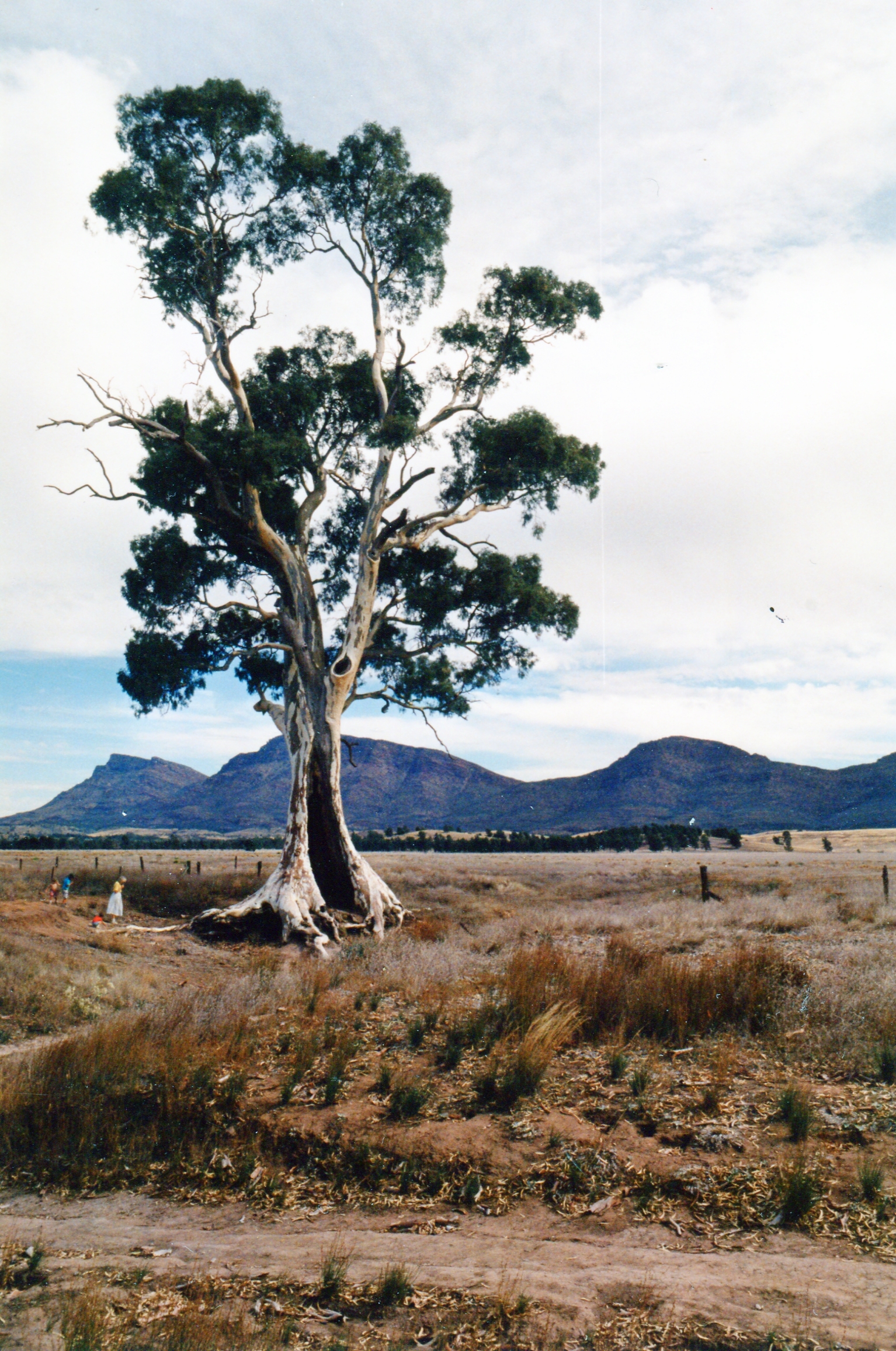 A euclyptus made famous by photographer Harold Cazeneaux. He photographed this tree in 1937 and named the image "Spirit of Endutrance". For more information check out this Wikipedia entry.
A euclyptus made famous by photographer Harold Cazeneaux. He photographed this tree in 1937 and named the image "Spirit of Endutrance". For more information check out this Wikipedia entry.
After turning off the main dirt road we took a narrow dirt track towards the apparently impenetrable ranges. Soon, we headed straight for a cliff of red brown mudstone and into a dry creek bed. This was to be our road for about 5Km. Most of the time the road was well marked but occasionally the choice was unclear. The kids, who had been asleep up until this point, really enjoyed the frequent creek crossings, the deepest of which was about 30cm.
As we travelled through the Brachina Gorge it changed constantly: one-minute narrow with almost vertical sides, another broad, with majestic river gums surrounded by entangled wood that had been swept downstream during the last flood. The debris included some huge trees. To drive along this gorge in a conventional car would have been impossible after rain and dangerous during it.
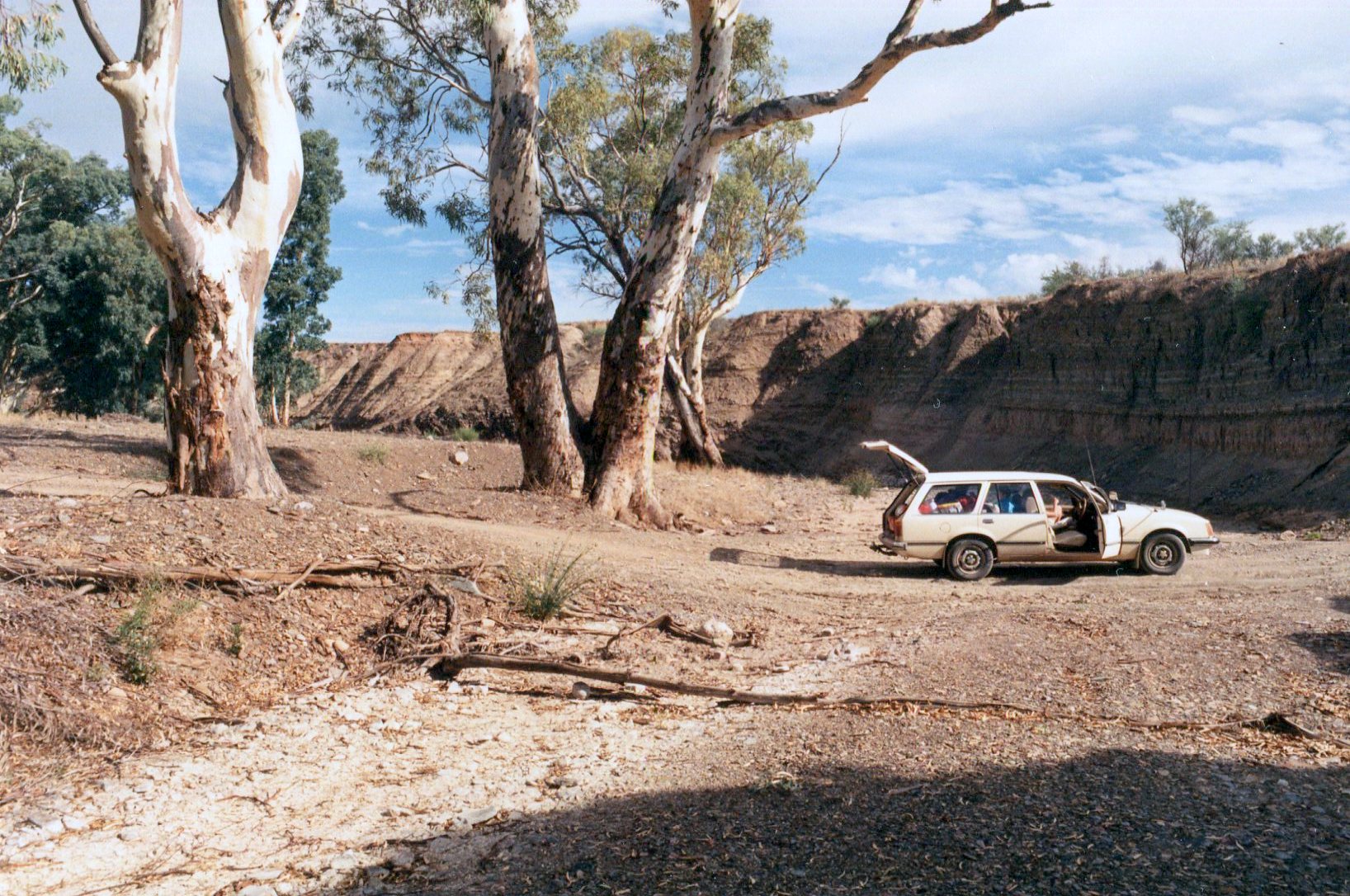
No need for a 4 wheel drive vehicle to get us through Flinders Range's backroads
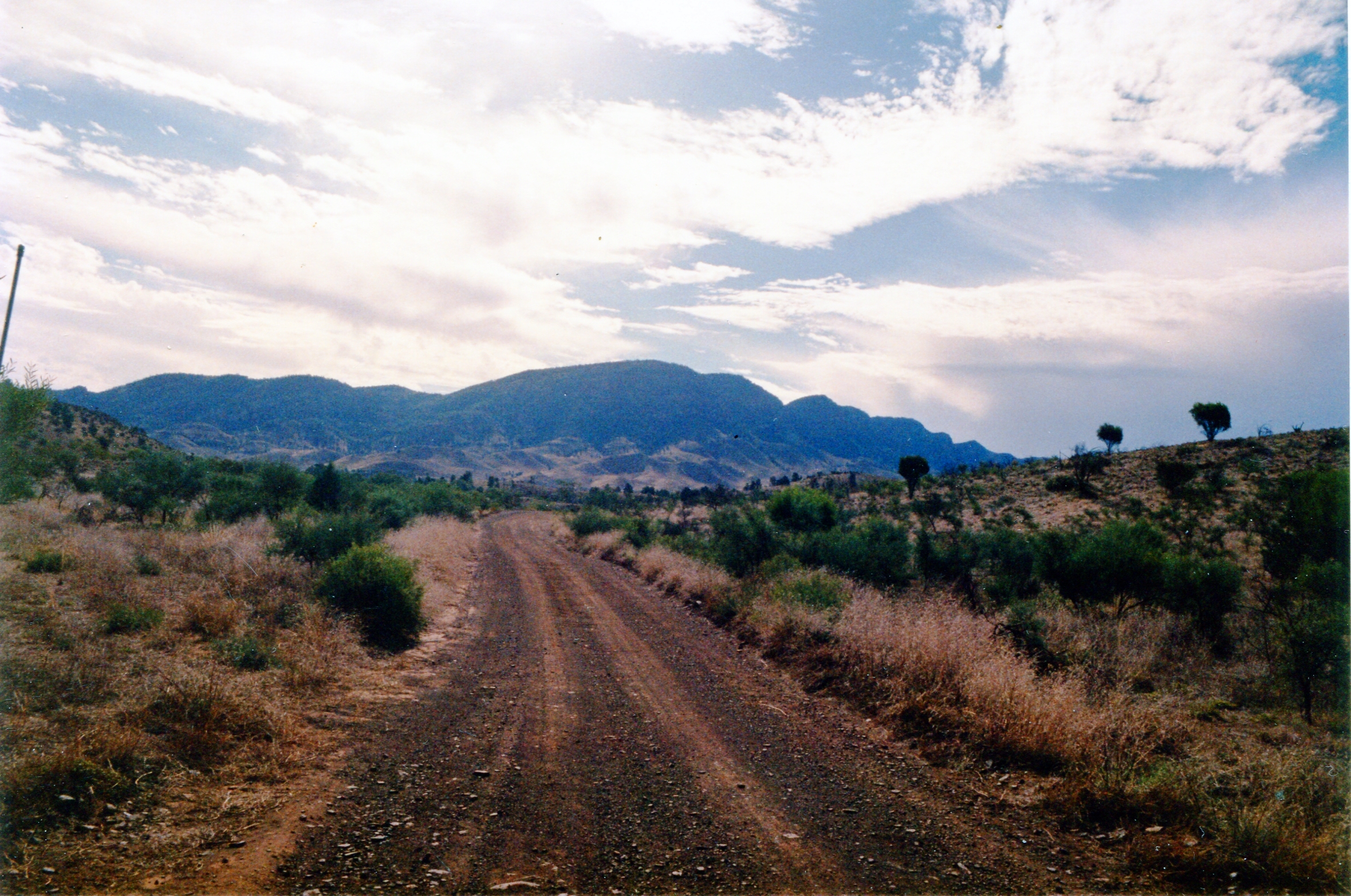 Inside the Flinders Ranges
Inside the Flinders Ranges
We emerged from the gorge and the Flinders Ranges more abruptly than we had entered. Suddenly, the hills were behind us and out to the west stretched an apparently endless plane. A few more kilometres of dirt and we were on the wide, flat, smooth and straight road to Leigh Creek. At Leigh Creek the road goes on either to the Birdsville Track or the Oodnadatta Track.
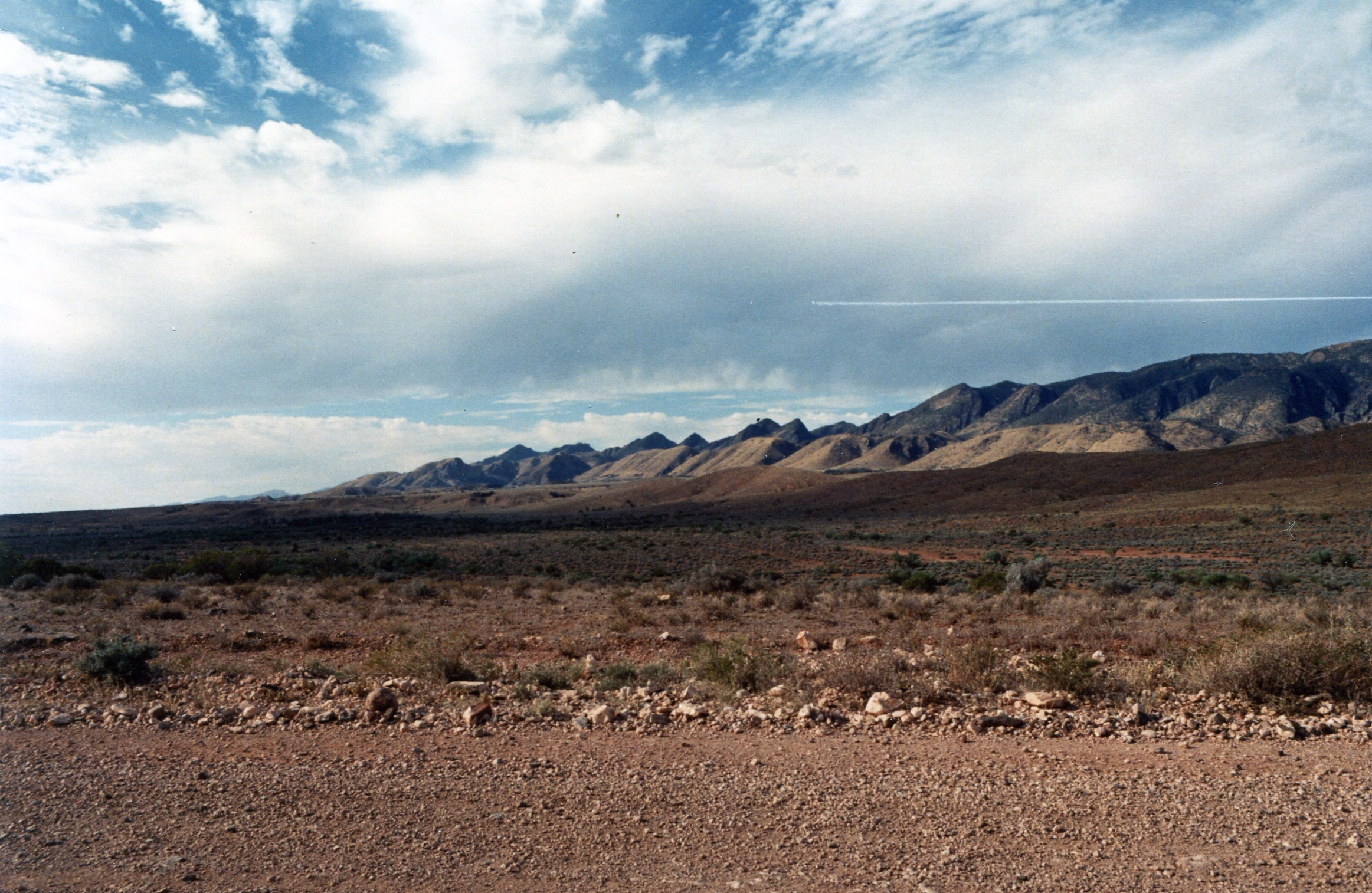
The western escarpement that marks the end, or the beginning, of the Flinders Ranges
Wednesday 21st March 1990
A hot wind blowing strongly from the North kept us company as we packed up. This didn't worry us as it meant we would have a tailwind for much of our trip, at least to Port Augusta.
The 1 hr, 107-kilometre trip to Port Augusta, saw us stop to move a dead Kangaroo from the middle of the road. This upset Jacqui and she described, in gruesome detail, what she would like to do to the person who ran over the kangaroo. The kids took up the theme and, for the next 20 minutes, described how they would dismember and mutilate the perpetrator of this dastardly deed.
Next, we witnessed a "dogfight" between an eagle and a blackbird (which could have been a currawong or a raven). Three of these blackbirds were harassing the eagle and winning. But when one got separated from the other two, the eagle decided to stand on its dignity and turn flight into fight. I nearly ran off the road watching the eagle outmanoeuvre the blackbird, frequently diving from above - each time the blackbird would flap out of range in the nick of time. I guess the blackbirds won as the eagle was no longer in their territory.
Port Augusta lies in the V of the Spencer Gulf and appears as you crest a low mountain range to the north of the town. The first thing to meet your eye is the huge power station, then the blue waters of the Gulf, in stark contrast with the brown of the surrounding countryside.
In town we visited National Parks and Wildlife only to find that, even though they were the divisional headquarters for this area, they had very little detailed information on their parks to give to us tourists. National Parks and Wildlife in South Australia provides a poor service for the traveller.
As usual, when we are in larger towns, we stocked up on food. As well, Jacqui posted off some paperwork to her tax agent and I found out who to see about registering our car in South Australia. What I mean by “registering our car” is getting a roadworthiness certificate to be sent off with the NSW registration papers to the Roads and Traffic Authority in NSW [2020 note; South Australia, in 1990, did not require a roadworthiness certificate in order to register a motor vehicle. I had to ask a mechanic to create one for that purpose.]
After lunch in a park we visited the local recycling depot. Arriving immediately before us was a group of locals in an old blue Holden ute carrying 500 kg of bottles and cans. Recycling appears to be a profitable way of life in South Australia. For a small box, containing 19 beer bottles and as many cans, Lachlan netted $2.26, much to his delight.
The road SE along the Eyre Peninsula is straight and passes through wheat and sheep country. Whyalla appears first as a brown smudge on the horizon and, on approach, resolves into a forest of buildings and chimneys - a carbon copy of Port Kembla. We resisted the temptation to stop there and escaped south to cleaner air.
When cresting rises, we could see evidence of fire in many directions. One large fire, judging by the pall of smoke above it, appeared to be in bushy country. Soon, though, it became clear that many of these fires were stubble fires in harvested grain crop paddocks.
Standing tall, beside the road, were huge grain silos where the harvested grain (most likely wheat) is delivered before being transported to Port Lincoln.
At around 5:00 PM we pulled into Port Neill, one of the small towns which have grown up around the grain silos. The kids played in a park besides the flat gulf waters and we all cooled off. Engaging a local fisherman in conversation on the jetty near the park, we were treated to lessons in the fine art of fishing. To catch garfish, he used the unique device shown below.
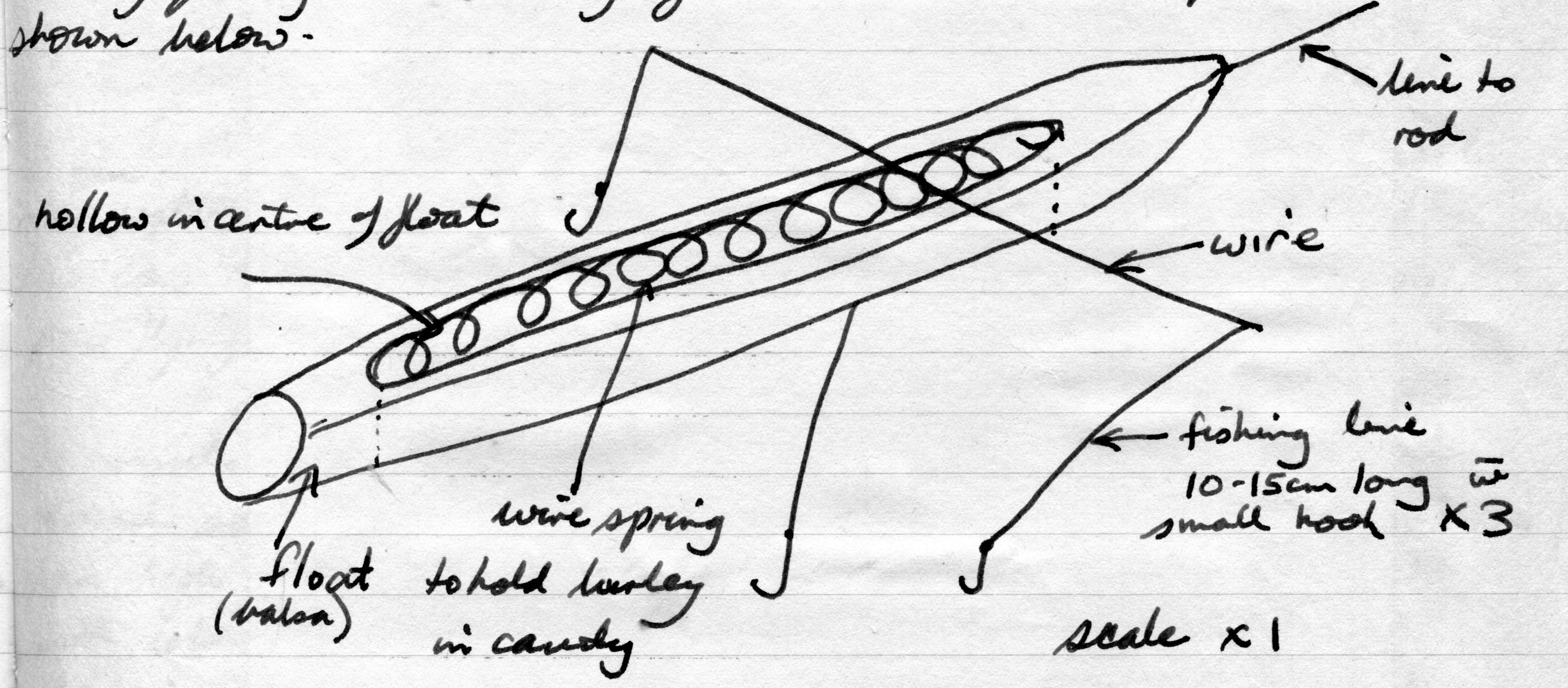
At 6:00 PM we headed south for port Lincoln where we had an excellent fish dinner at a takeaway fish shop called Captains Catch. We must have appeared a poor crew as the proprietors gave us three containers of rice pudding.
Before leaving Port Lincoln we did a quick tour, although not much could be seen in the dark. What we did see was a port town with huge grain silos and an extensive rail network. The sea here was extremely calm because of the lack of breeze, the sheltering effect of adjacent islands and the Lincoln National Park.
At a Mobil service station, we met John who spent a long time talking to us about local attractions. He told us to visit Smoky Bay and to see Tom at the local store to get the lowdown on fishing.
Nearly 3/4 of an hour and 46 kilometres down the road, we arrived at Coffin Bay, where we spent another 30 minutes being told more about the area by the slightly drunk caravan park proprietor. The van went up in the dark, the kids were showered, and bed looked inviting at around 11:00 PM.
The end of a long day and 503 kilometres.
Thursday 22nd March 1990
We spent the first part of the morning washing and I replaced the caravan’s water pump - yes, the one that I had repaired yesterday. This time, I screwed a tin can around the pump body to protect it from being damaged by rocks thrown up by the car and caravan wheels. [2020 note: this tin can survived the rest of the trip and remained in place for the duration of our ownership of the van.]
This done, we drove into Coffin Bay National Park. After about 20 minutes on a rough dirt road, driving through scrub covered sand dunes, we were rewarded by spectacular views of the ocean from high white cliffs. Below, the sea was an intense blue with islands and reefs nearby. After a further short drive and a shorter walk, down treated pine stairs, we were on a superb white-sand beach. Small waves were breaking at this end of the beach as it was protected by an island and a shallow reef running from the mainland: these features absorbing much of the big ocean swells’ energy.
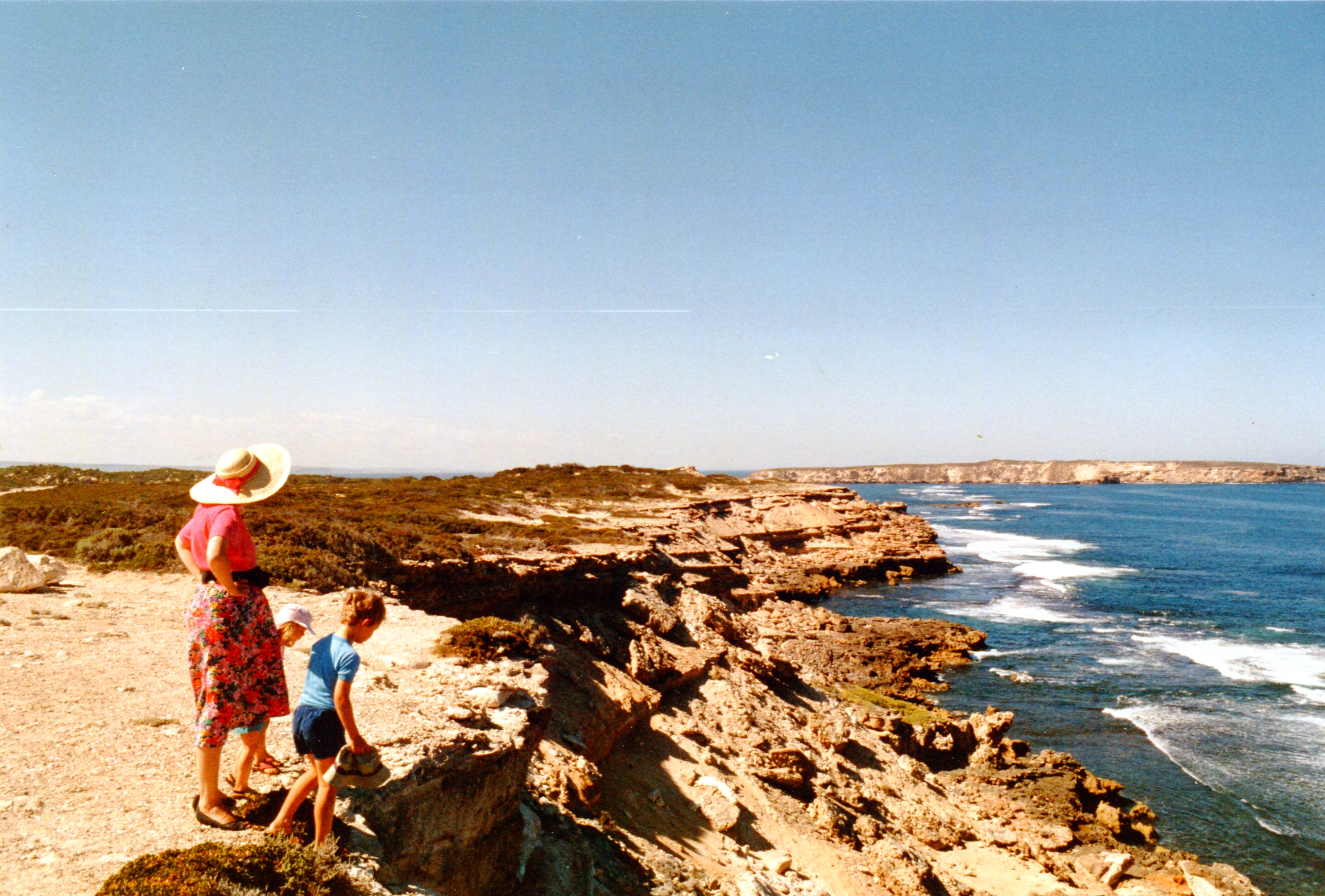
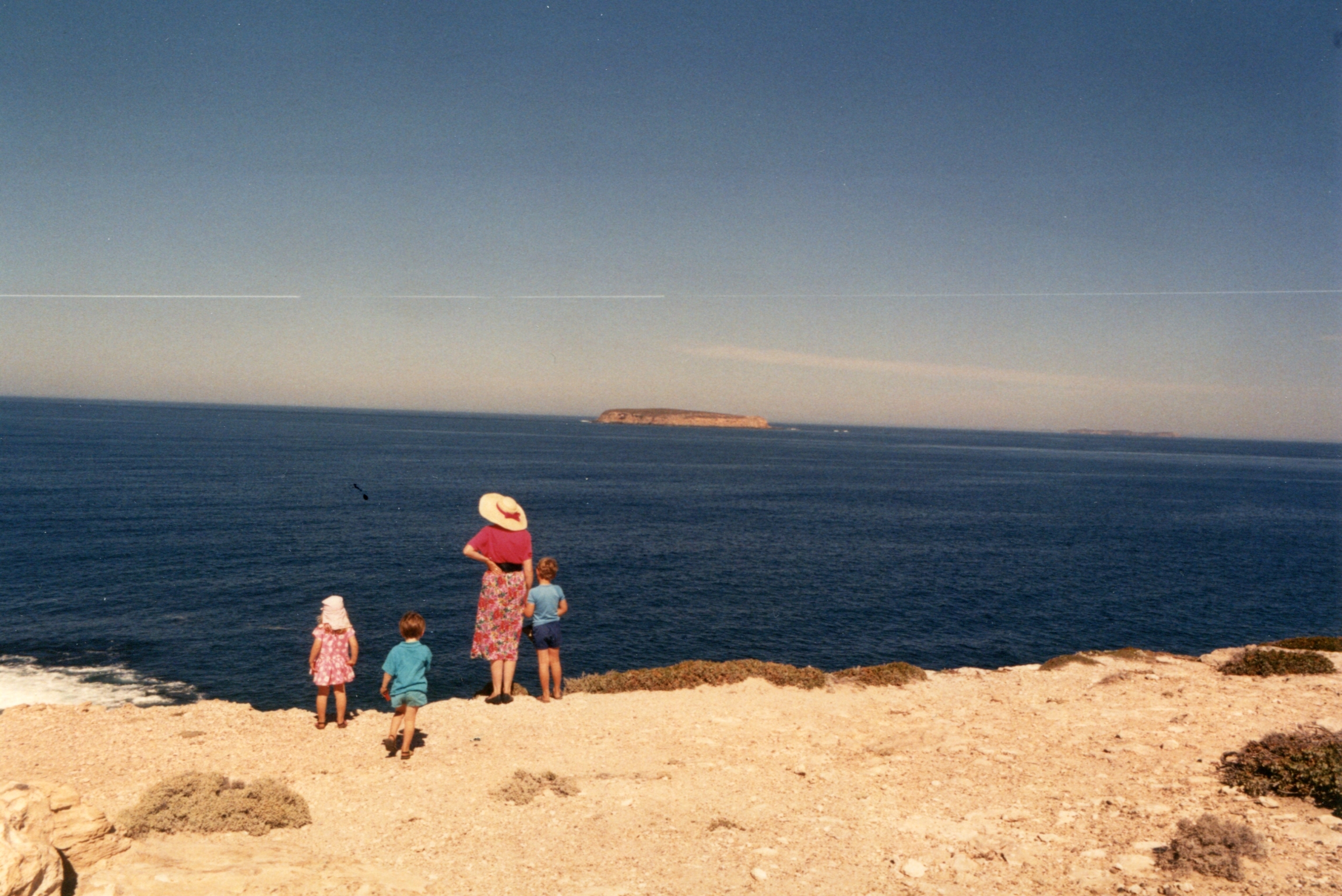
The spectacular coastline that is part of Coffin Bay National Park
While we were there a pod of about 20 dolphins - browner in colour than others I had seen - cruised slowly up and back along the beach in front of us. At times individuals would surf on or in the small waves and occasionally jump almost completely out of the water.

The beach in Coffin Bay NP where were saw dolphins
It was one of those mornings where everything conspired to make you feel good and to celebrate being alive: the bracing water; cool sea breeze; blue cloudless sky and happy kids. What else could you ask for?
With tummies rumbling we bounced back to camp for lunch at about 12:30 PM. On the way I picked up the mail at the post office. Included, from Elaine and George, was an unused Olympus Trip 35 mm film camera for the kids’ use. This proved to be a big hit with them! [you will see some of the photos they took in later sections of this diary]
After lunch, we lazed around until about 4:00 PM when the kids’ nagging worked its magic spell and I agreed to take them fishing. We rigged up, bought cockles for bait at $1.80 for 200g and walked to a nearby sandy beach/boat launching ramp in Coffin Bay. Here the hire boat joint had a steel mesh jetty and they allowed us to fish from it for mullet. When I put a small hook on the line, I caught a mullet, which was subsequently used as bait to catch some biggies – but instead of a big fish, we nearly caught a seagull!
The owners of the hire boats were cleaning scallops and whiting on the jetty and gave us the lowdown about where to catch both the aforementioned organisms. We watched as they cleaned their catch and threw the unwanted bits into the water. Millions of mullet swooped for the food along with 3 sharks, which looked more like rays. Several small whiting cleaned out the scallop shells.
Jacqui's salivary glands were working overtime at the thought of whiting for dinner. In the end we paid $1 for four whiting fillets that weighed about 200g. These were put on the barbie next to the rump steak for our dinner.
Friday 23rd March 1990
The idea was to go for an early dive near the hire boat wharf to search for scallops. We planned to do this while the tide was low and the water shallow. The reality was that with Jacqui and I chatting to Gary and his Swiss wife, we were later than expected - but what's new?
The water was warm, too warm for my wet suit, and after swimming about 65 metres to get clear of the weeds and into deeper water where there were sandy patches, I began to find scallops. They were generally near the weeds at the edge of sandy hollows and often completely encrusted in barnacles or weed. The scallops sensed my presence and snapped shut before being touched. I'm not sure how long I was at it, maybe an hour, maybe less, but in that time, I managed to fill my bag so that it was too heavy to swim with. What I did was to tie it to my float and swim back to it each time I had a handful. On the bottom, as well as scallops, were innumerable oyster shells and almost as many cockles, both dead and alive. A few of the living cockles were collected for a fishing trip we were planning for later in the day.
Back at the wharf, Jacqui and I spent until around 11:00 AM cleaning the scallops. I would open them with a sharp, strong knife, and Jacqui would trim off the frilly and gutsy bits. Several hours work netted one full dessert bowl of clean scallops, weighing around 300 to 500 grams.
By the time we had returned to the van, put the scallops in the refrigerator, organised lunch and collected fishing gear it was 11:30 AM before we picked up our hire boat - a 4-5m long aluminium runabout with a 30 horsepower Mariner outboard.
As we motored slowly to the channel of Coffin Bay, the wind dropped, and we could see the bottom as clearly as if we were diving.
Slowly at first, and then more quickly, we motored to a huge shallow bay where we ate lunch on a low shelly island covered with sparse grass. From there we skimmed over the slightly ruffled water to a likely looking fishing spot, which turned out to be marginally productive. I caught three king george whiting, however only one was legal size at 26 centimetres.
We moved once more before speeding back to the ramp, so we paid for three hours of boat rental costing $36: of which $30 was for the boat hire and $6 for fuel.
Not being content with one fish Jacqui insisted that we go fishing again, which we did on a concrete horseshoe-shaped wharf east of the town. Unfortunately, we didn't catch anything, dare I say, “as usual.”
Dinner was superb with fish, cockles, and scallops in a white wine sauce with pasta. Yum!
Saturday 24th March 1990 (Federal Election Day)
I left at 7:00 AM and dived again for scallops. This time the tide was still flowing out so I needed to swim against the current even to remain stationary. However, through a mammoth and monumental effort of will and fantastic, almost unbelievable, strength, I managed to pick up a bag full of scallops. Most were smaller than the previous day, as to swim out to the deeper and more productive scallop beds was beyond even my Herculean efforts. Jacqui annotated the diary with “Yahoo Superman!”
We didn't bother to clean the scallops and packed up, getting away at 11:00 AM. Even though it was cloudy, the mercury rose steadily as we headed north towards Elliston and our ultimate objective of Streaky Bay. We drove through typical Eyre Peninsula countryside i.e. flat to rolling countryside, in general very dry and with a significant number of salt lakes in the lower depressions.
At Elliston, our lunch stop, it was cooler, being much closer to the water. We spent nearly 1 1/2 hours here before driving the last 100 kilometres to Streaky Bay where we arrived at 3:00 PM.
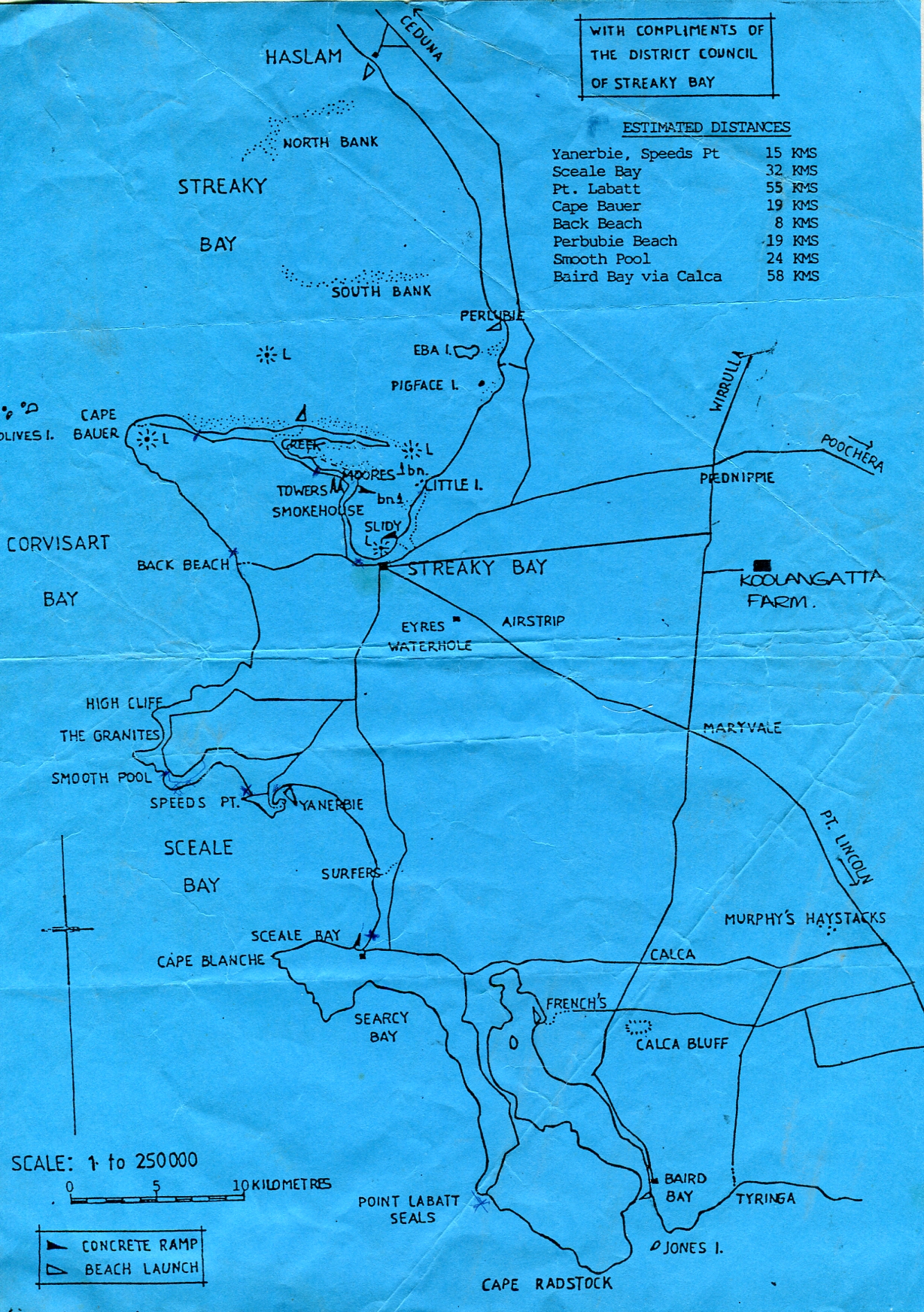
A council provided map of the Streaky Bay area. We visited Point Labatt to see Australian Sea Lions, and Smooth Pool where I had a very successful spearfishing session
Before stopping at the caravan park, we visited the polling booth and found that, if we ever receive our voting papers that should have been forwarded to us by mail, the names of the groups are on the voting paper for the Senate.
At the polling booth a farmer lady told us they received only 7 inches of rain a year to grow a crop.
The caravan park is good, grassy, and shady. I met some “blokes” who have agreed to take me collecting razor fish in the early morning.
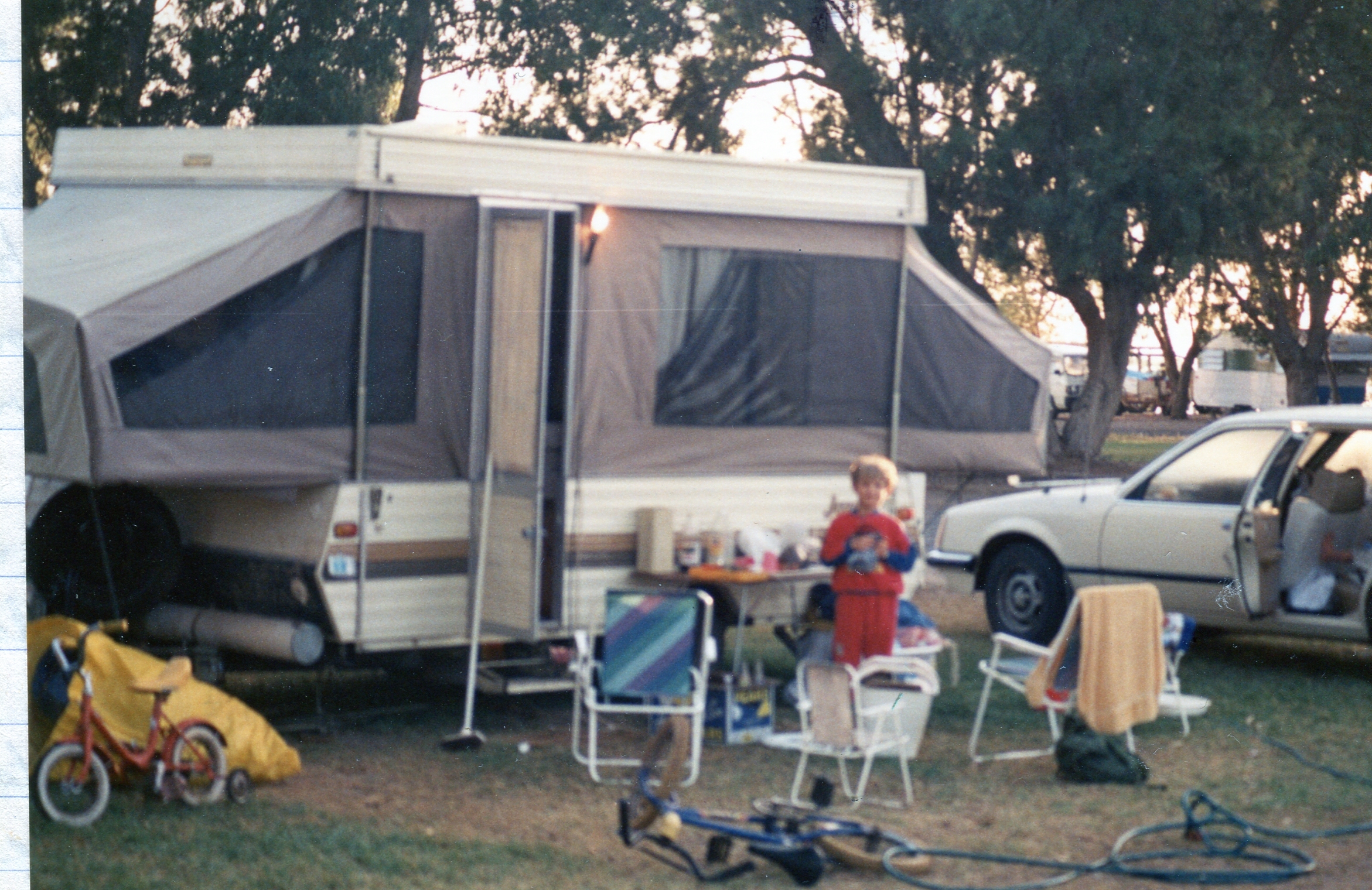
Our Streaky Bay campsite was delightful. Here's Lachlan doing the washing up
Jacqui and I spent the evening listening to ABC radio and its election broadcast.
Sunday 25th March 1990
Unfortunately, the night didn't end when we went to bed. After writing up the day's diary entry and with an undecided election hanging in the air, millions of mossies plagued us and kept both of us up for hours. We were either scratching and sleeping in the dark or working as a totally ineffective team swatting at them with the lights on. It remained hot all night and, making sleep even less accessible, some clown drove up and down the street until 4:30 AM. At 6:15 AM, true to his word, our neighbour Peter woke me and by 6:30 AM Peter, Dave, Darrell and I were heading around streaky Bay to collect our quota of 50 razor fish. These are large shellfish – they are shown in the diagram below copied from our diary:
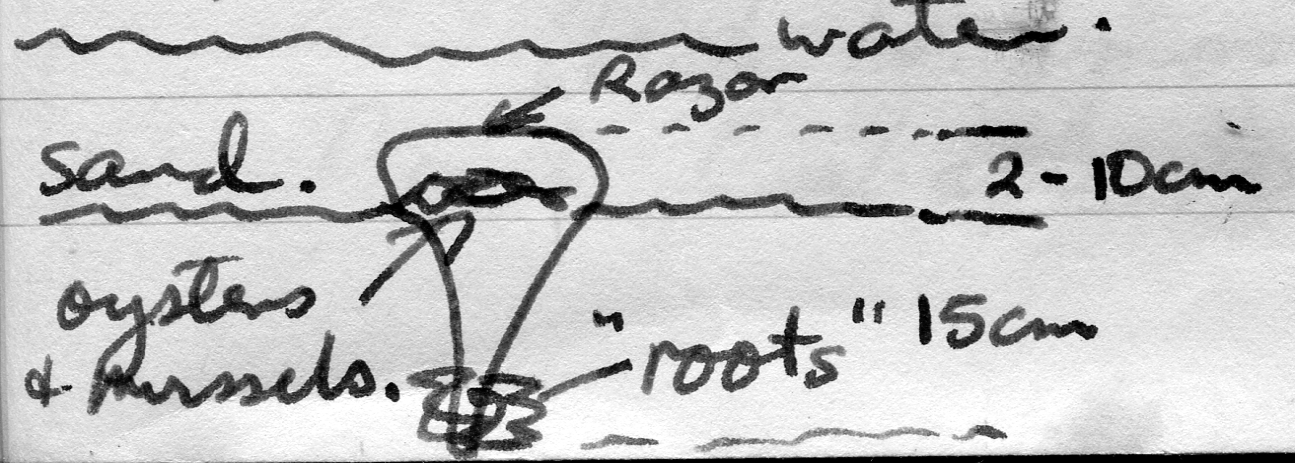
They are aptly named, as that part sticking up above the sand is literally razor sharp.
The harvest begins when they are manhandled out of the sand, a difficult task as they are firmly rooted in place. Next the pointed end is knocked off – I used my heavy divers’ knife. Then the closing muscle is severed by inserting the knife into the broken end. Once open the guts are simply pulled off and discarded, while the remaining attachment of the muscle to the shell is cut and the firm white “heart” is put in your bucket.
There is a quota of 50 per person per day, however, as there are literally thousands to be had they appeared to be in no way threatened by the harvest. There is no commercial harvest yet, or so I'm told. Some people even use them for bait! [2020 note: The current restrictions are: No minimum legal length; Personal daily bag limit: 25; Possession limit: 100; Daily boat limit when 3 or more people are on board: 75; Closed season - 1 October until the end of February each year in an area of Upper Spencer Gulf]
When fried they taste like scallops but are a little tougher to chew on. The flesh is larger than a scallop - being on average 2-3cm in diameter and about ½ to 1cm thick.
I was back in camp by 8:30am. After breakfast and a few chores, we packed the lunch and car for a trip to some of the local attractions.
First, after 15 kilometres of good limestone road we stopped at Smooth Pool. Here was a narrow, V shaped Bay, in granite which is overlain by gently dipping limestone. Smooth pool is the name given to the semi-open rock pool about 200m in diameter. From here we went to a nearby calm section of ocean, more open to the sea and accessible by scrambling down a tumble of boulders. I donned wet suit and spent 3/4 of an hour terrorising the local fish population within 50m of where I entered the water. The final bag was 6 mowong and one drummer. I hit but lost 2 huge salmon like fish and one gigantic drummer. I will sharpen my spear prongs!
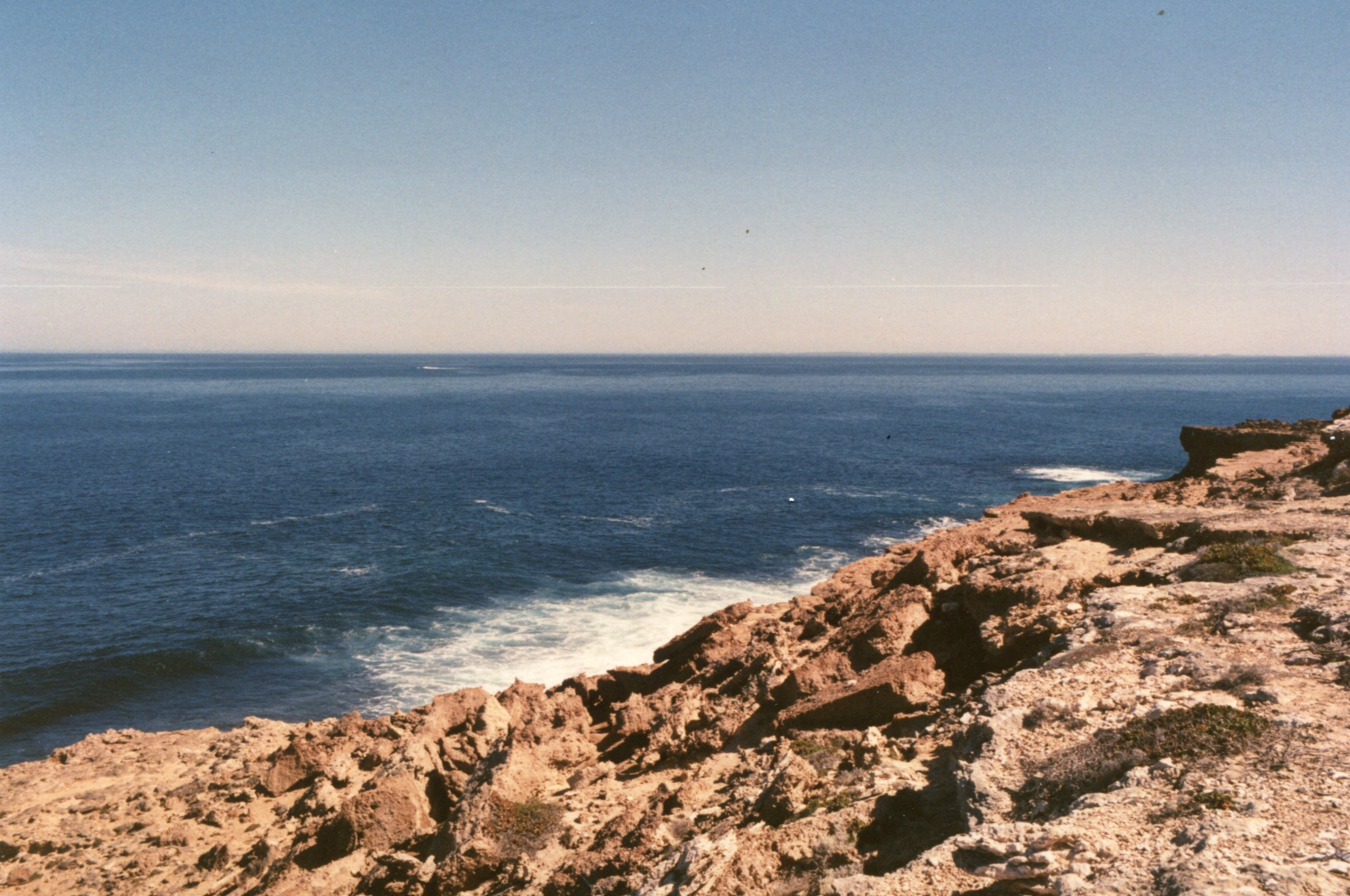
The Great Australian Bight as seen from the limestone cliffs near Streaky Bay
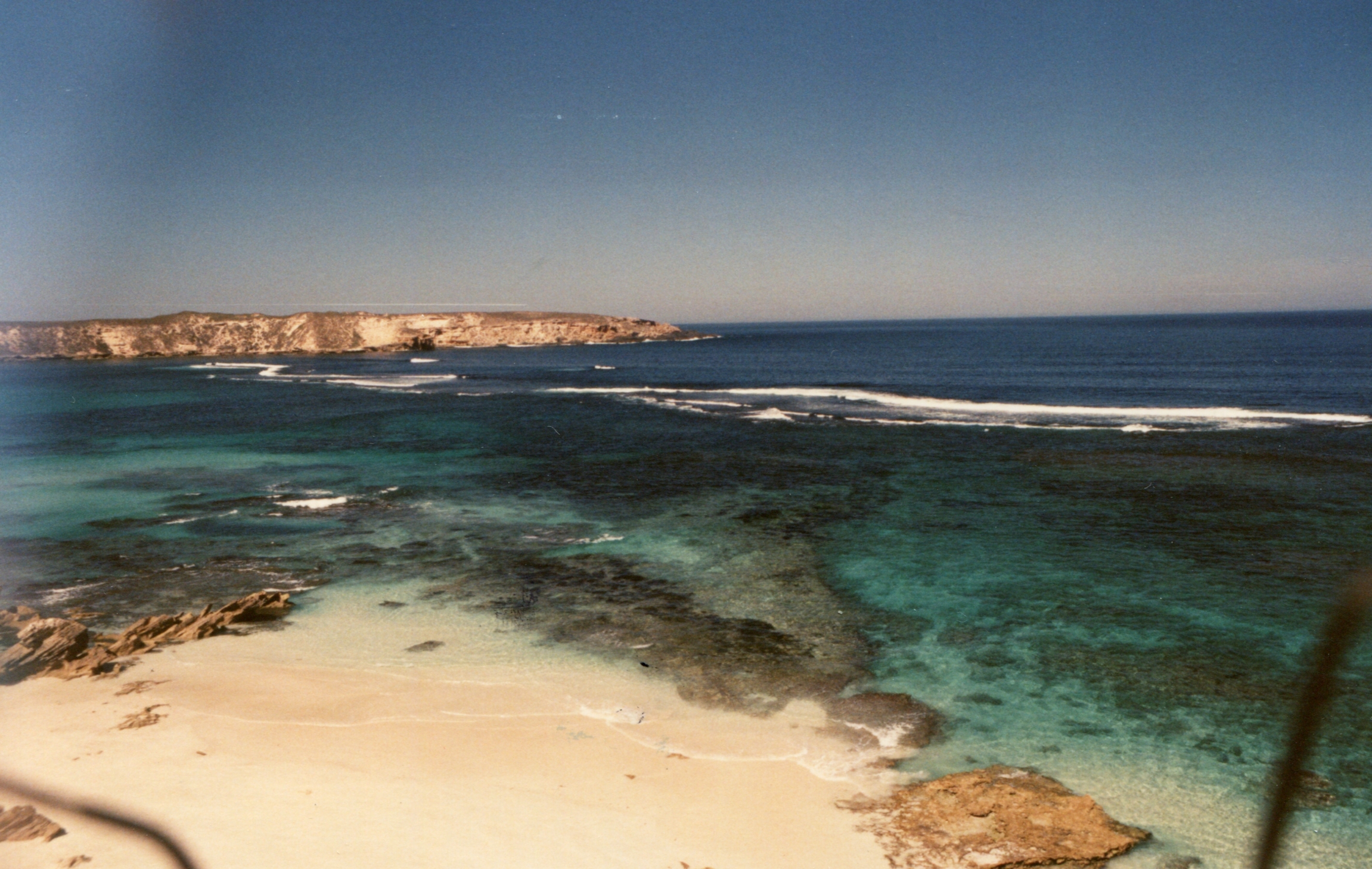
Looks like a good diving spot - but I didn't dive here as we had been repeatedly warned about sharks - we dived at Smooth Pool instead but I have no photos :(
Back to smooth pool for lunch and then onto Port Labatt to view the local sea lion colony from a 30 m high cliff. We saw about 15, all lying about warming in the sun - or at least they were sheltered from the very hot northerly wind which threatened to blow us all over onto the rocks below. Little activity was observed, but a loud shout brought a few heads up.
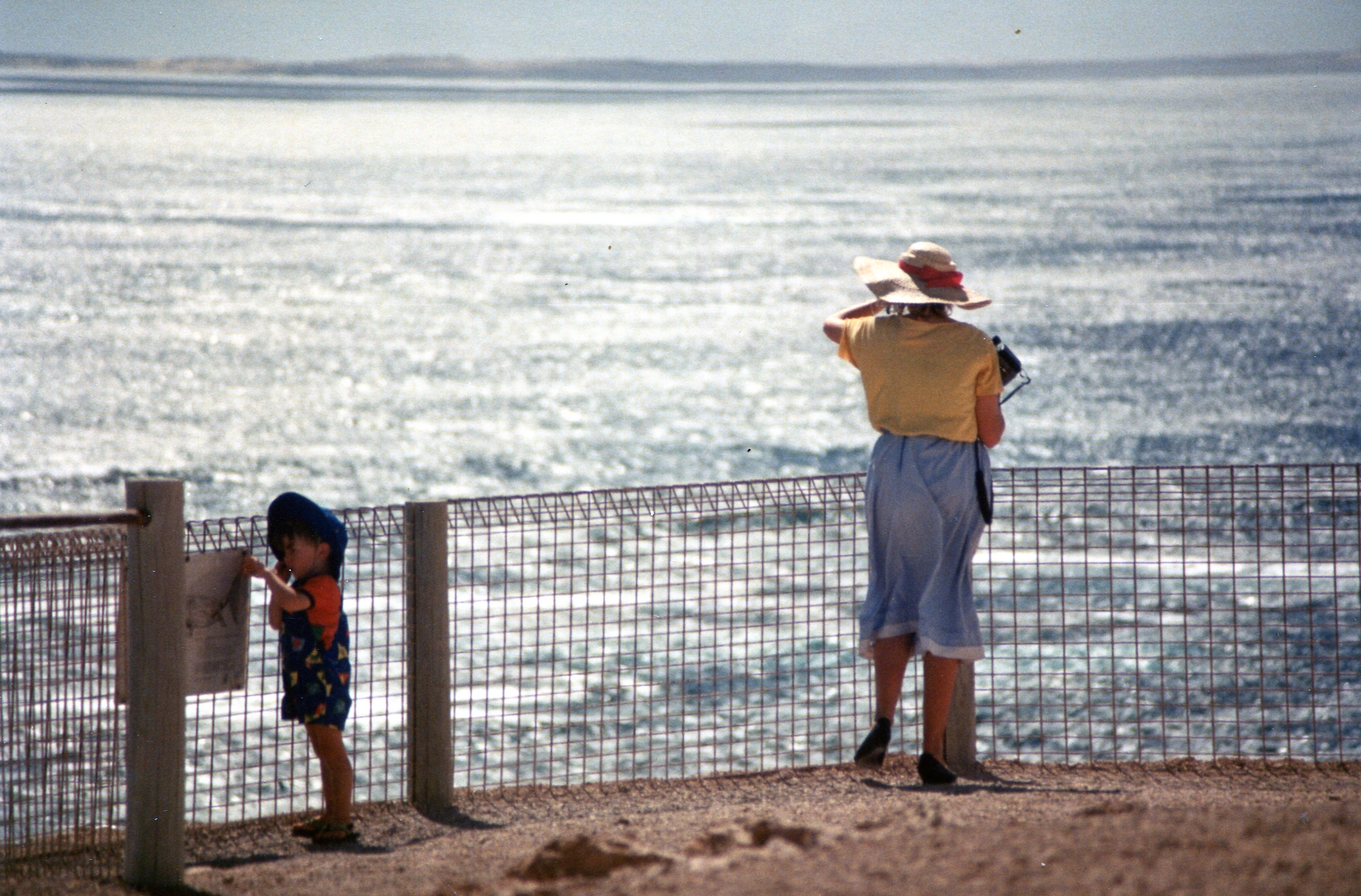
The lookout above the seal colony at Point Labatt. Rohan appears more interested in the sign than the seals
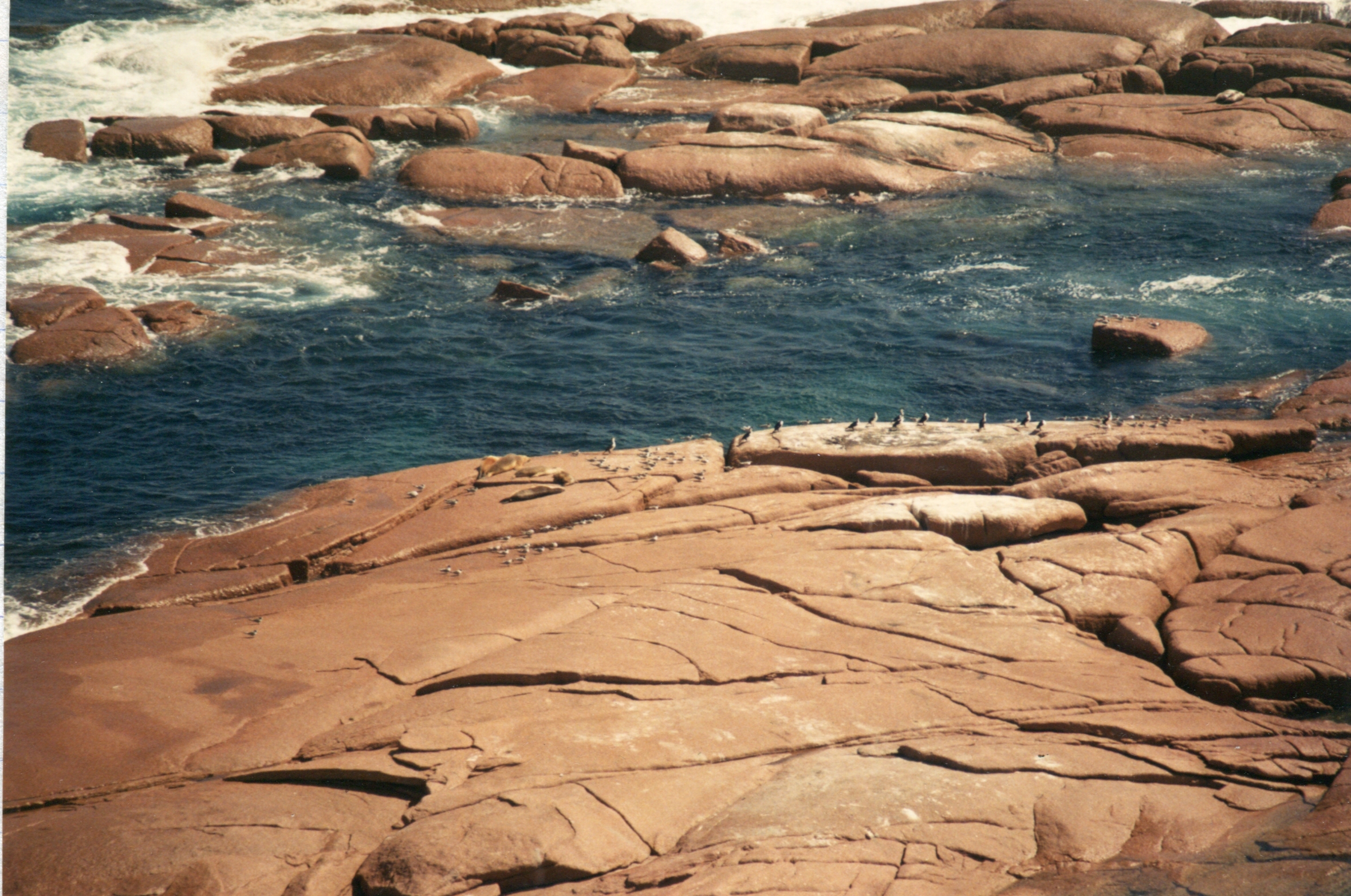
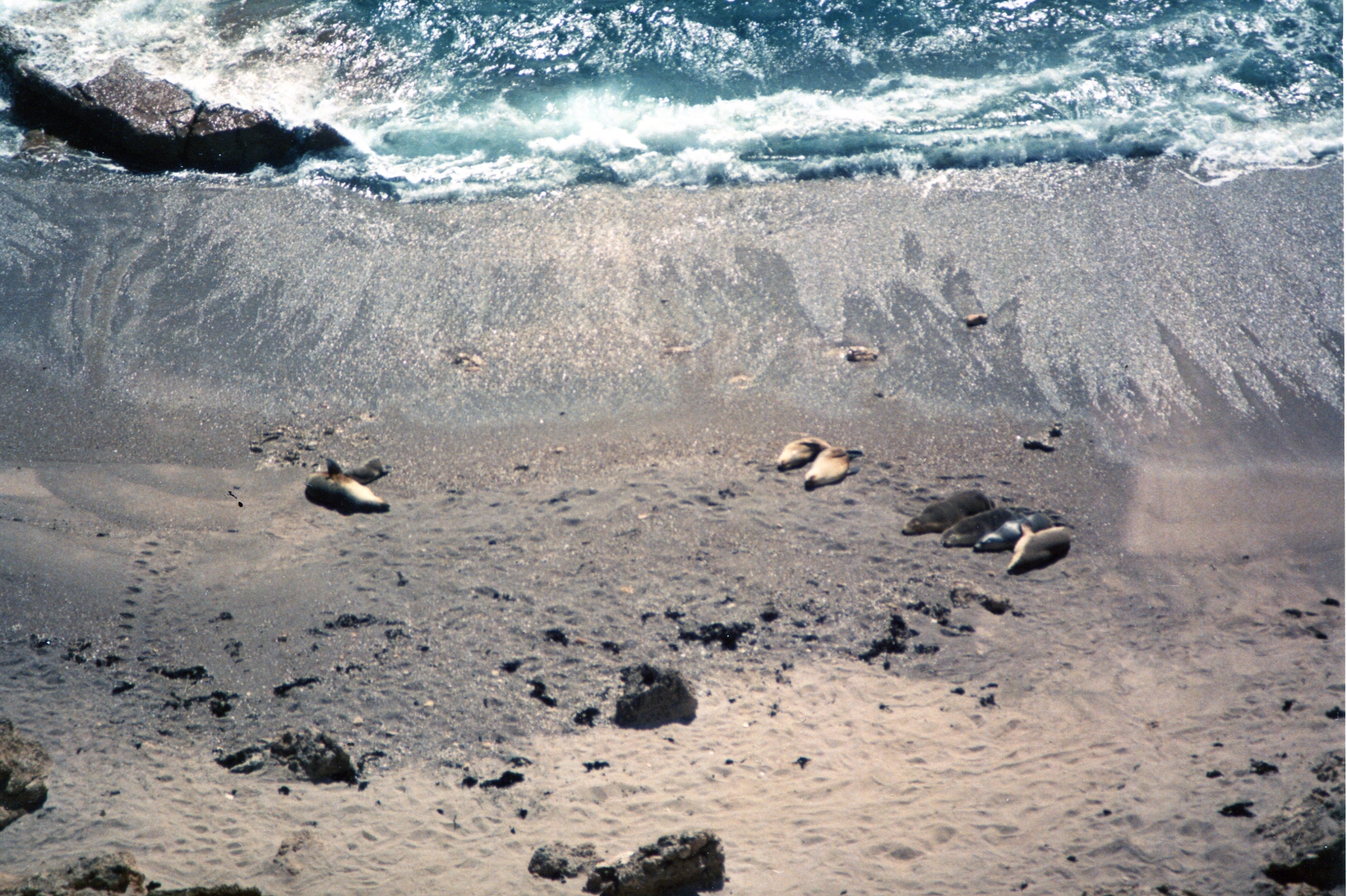
Point Labatt seals
I did see what I assumed to be a bull chase a young’un for about 3m.
By this time in the proceedings it became clear we were all hot, dusty, thirsty and sick of being in the car. So back to camp where a cold drink and ice cream awaited after we had travelled nearly 150 kilometres - mostly on dirt.
Rohan had fallen asleep, so I stayed nearby and cleaned the fish while he slept. Jacqui took Anja and Lachlan to fish from the town “woof” (what Lachlan calls the wharf), for squid and anything else that swims.
Monday 26th March 1990
The forecast was for a very hot day with a late change. A day in the car with the air temp at 30 degrees C+; no air conditioning and the kids complaining about being too hot, didn't appeal, so we decided to remain in Streaky Bay for another day. I went razor fish fishing again with Peter and Dave in the early morning.
After visiting the Post Office, from where we sent off our Postal votes [for the general election held several days previously], we bought bread etc and then returned to camp.
The forecast was right, and it was a stinker, with a very strong N-NE wind making fishing unlikely, so we sat around a lot and the kids swam.
At around 4:00 PM the wind dropped, I bought 2 squid jigs and we headed off to the wharf. At 4:40 PM, the wind died completely and from my vantage point on the wharf I watched the change sweep across the Bay from the Southwest. This cooled things down and everyone sighed. Again, it was too windy to fish, so we went to a garage on Mudge St where I got an inspection certificate for the car and posted it off [To the NSW RTA] priority paid. The night was spent packing.
Tuesday 27th March 1990
Peter woke us at 6:10 AM and we had brekky and packed the van ready to leave by 8. Allan and Gail were also leaving. We spoke to them over the CB Radio from Streaky Bay until we arrived at Ceduna.
In Ceduna we bought: fuel at $0.72 per litre; a jerry can; a few groceries and checked for mail before hitting the Nullarbor.
The first few hours of the trip are through wheat and sheep farming country and, though the road is straight, it dips and bobs with the roiling hills. Abruptly the scrub stops, and the country flattens just after the Yalta aboriginal community 200Km west of Ceduna. The true Nullarbor begins.
At Nullarbor Station, we filled up with $15 worth of super at $0.84 per litre. "It's cheaper at Bordertown" we were told. [2020 note: now known as Border Village – there is another place in SA called Bordertown]. The day was long but at least the air outside was cool, even if it was a headwind.
Bordertown petrol was $0.88 per litre and to fill, which we did at Eucla, cost $54.00. So much for cheaper fuel! We also checked unsuccessfully for mail. There is no post office in Eucla!
The highlight of the day was pulling off the Eyre Highway, travelling about one kilometre to the south, and being at the edge of the great Australian Bight. Here huge seas crashed into the almost vertical cliffs for as far as we could see. Truly stunning and quite unexpected given the monotony of the Nullarbor!
About 110 kilometres further down the track into WA we pulled into a free, no facilities, camping area, setting up the van while leaving it attached to the car. 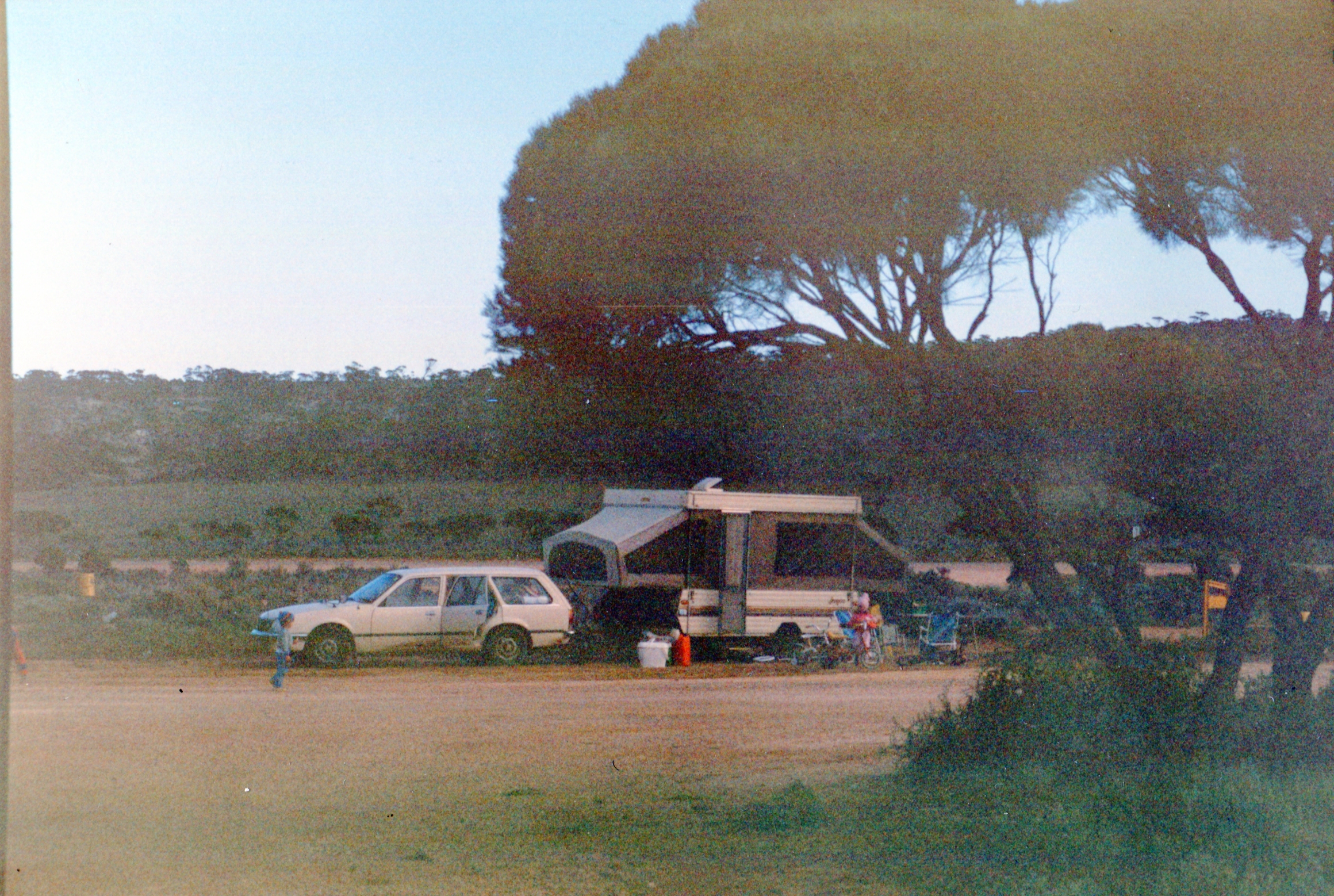
One of the many free camping sites on our trip. This one was 110 Km on the WA side of the WA/SA border
Links to other posts
In the beginning: Motivation and Planning
NSW: Merry Beach, Bournda State Recreation Area
Victoria Pt 1: Mallacoota - Lakes Entrance, Lakes Entrance - Melbourne
Tasmania: 1st - 18th February, 19th - 27th February
Victoria Pt 2: 28th February - 12th March
South Australia: 13th March - 27th March
Western Australia Pt 1: 28th March - 17th April
Western Australia Pt 2: 18th April - 5th May
Northern Territory: 6th May - 17th May
Queensland Pt1: 18th May - 31st May
Queensland Pt 2 to Sydney: 1st June - 20th June